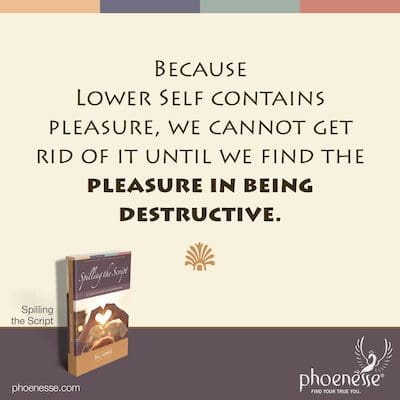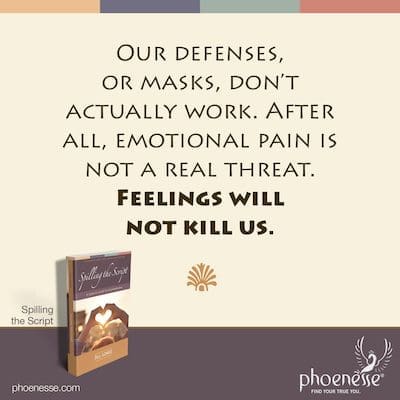People are complicated. There are many layers of the self, and various aspects tend to overlap and borrow traits from one another. This makes it difficult to explore this material in a linear fashion. Let’s get things underway by meeting the selves with this brief introduction to the layers, each of which will be explored in greater depth.
Read a summary of the qualities of the self, as taught by the Pathwork Guide.
The Higher Self
The Higher Self takes practice to connect with, it may not have words, and it is full of paradox. It is all things that are good and serve connection with the self, others and all that is. It says, “I can’t do this alone” and surrenders to God.
The Lower Self
The Guide teaches that any truth can be distorted, and that’s really what the Lower Self is – a distortion of pleasure into pain. All negativity derives from the cross-over of pleasure and pain. Because Lower Self contains pleasure, we cannot get rid of it until we find the pleasure in the destruction. Then we can reconvert that distorted energy back into its loving, flowing form. To do this, we must also understand and correct the associated wrong thinking.

The Little-L Lower Self
Little-L Lower Self is the ignorant, illogical inner child who wants 100% perfect, exclusive love and to always have its way. Neither are possible so it feels rejected and frustrated. Not having these false needs met makes the child feel inferior, so it draws wrong conclusions about its value. It develops other faulty ideas about itself, others and life.
It suffers from being trapped in life-or-death duality, and from feeling scared and rejected. It attempts to block these painful feelings by stopping its breath, thereby freezing the energy of these feelings in the body. Its response to life is “I can’t,” as in “I can’t feel this, or I’ll die.”
It attaches its natural drive for pleasure – which is its life force – to the painful experiences. To avoid future pain, it chooses a defense, but this doesn’t work. It dons a mask of perfection designed to compensate for the missing self-esteem, hoping that if it is perfect enough, it will get love. This also doesn’t work.
The Big-L Lower Self
Big-L Lower Self creeps in, turning the child’s defense into a strategy to win. It wants to rule. It demands love but resists giving. Its intention is to stay stuck and stay separate, not letting the parents off the hook for the pain they caused.
This hidden tyrant is cruel to the self through inner criticism, and to others through bullying, betraying, holding back and seducing/rejecting. It derives pleasure from this destruction, activating the life force by recreating the painful climate of the child. It uses the misconceptions of the child to justify all of this.
The Lower Self uses competitiveness to overcome feelings of inferiority, building cases against others and maligning them. It fears the pain of humiliation and sets a negative intention to never give in. Its response to life is “I won’t,” as in “I won’t give and I won’t ever give in.”
The Mask
When we begin down this path, shame is the first thing we run into. Shame is the feeling that we are exposing something we need to hide. It is the outer layer of our mask. The mask is a strategy intended to get love and defend against pain. It does neither, and being only a strategy, it isn’t real.

It uses sickly sweetness or attacks to manipulate and control others, or detaches in false serenity. It uses blame, victimhood and judgment to turn the focus outside the self. The Idealized Self Image attempts to create a perfect version of the self but it is fake and instead creates more rejection.
The Ego
The unhealed ego is immature and wants to reign supreme, saying, “See me, I’m better than you, love me for it.” It uses drugs and distractions to avoid focusing, and to escape or transcend itself. It needs to become strong enough to make a choice to seek God. It is a necessary servant for the soul to do this work, but it is not the master.
The mature adult ego is the compassionate, objective observer that chooses to connect the Higher Self with the inner child. It prays to see the truth, surrenders, and needs to die many little deaths. It will eventually dissolve into the Higher Self. The healthy ego commits, wants to see misconceptions, and is willing to pay the price.
The Universal Self
While it is essential to dissolve childhood conflicts, the greater aim of this work is to transition from the isolated, self-centered, dualistic state to the state of union with all that is. Our objective must not stop short at the purification of the Lower Self but strive endlessly toward this greater fulfillment in the unitive state of consciousness.

The Story of Two Wolves
From Native American Indian Wisdom
An old Cherokee is teaching his grandson about life. “A fight is going on inside me,” he said to the boy. “It is a terrible fight and it is between two wolves. One is evil – he is anger, envy, sorrow, regret, greed, arrogance, self-pity, guilt, resentment, inferiority, lies, false pride, superiority and ego.”
He continued, “The other is good – he is joy, peace, love, hope, serenity, humility, kindness, benevolence, empathy, generosity, truth, compassion and faith. The same fight is going on inside you – and inside every other person, too.”
The grandson thought about it for a minute and then asked his grandfather, “Which wolf will win?” The old Cherokee simply replied, “The one you feed.”
Return to Spilling the Script Contents


